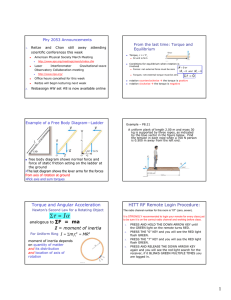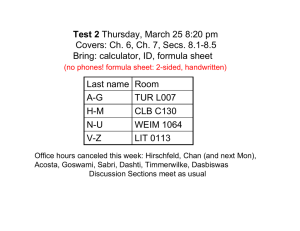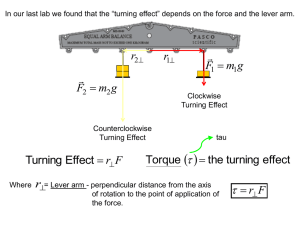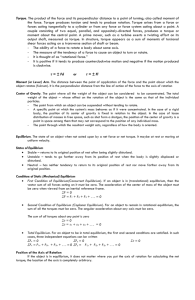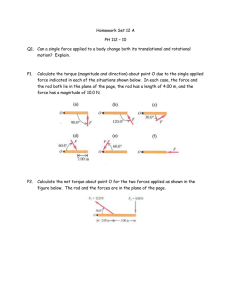Rotation: Worksheet 3 More Torque and Static Equilibrium
advertisement
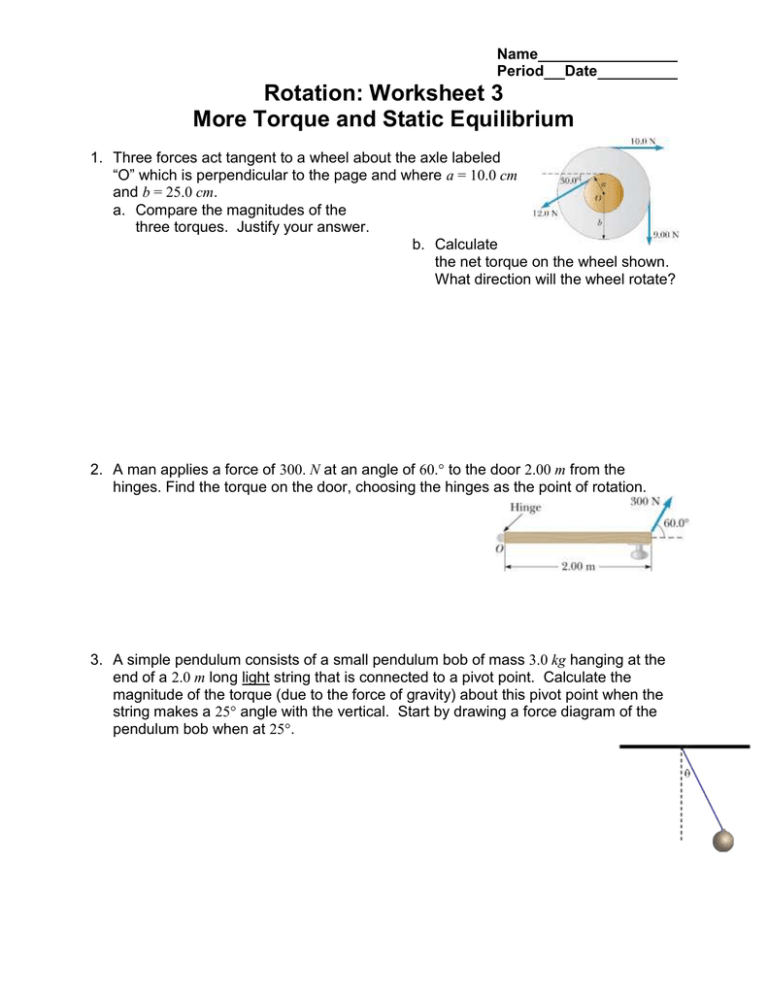
Name Period Date Rotation: Worksheet 3 More Torque and Static Equilibrium 1. Three forces act tangent to a wheel about the axle labeled “O” which is perpendicular to the page and where a = 10.0 cm and b = 25.0 cm. a. Compare the magnitudes of the three torques. Justify your answer. b. Calculate the net torque on the wheel shown. What direction will the wheel rotate? 2. A man applies a force of 300. N at an angle of 60.° to the door 2.00 m from the hinges. Find the torque on the door, choosing the hinges as the point of rotation. 3. A simple pendulum consists of a small pendulum bob of mass 3.0 kg hanging at the end of a 2.0 m long light string that is connected to a pivot point. Calculate the magnitude of the torque (due to the force of gravity) about this pivot point when the string makes a 25° angle with the vertical. Start by drawing a force diagram of the pendulum bob when at 25°. Rotation: Worksheet 3 page 2 4. A beam of mass m and length L can rotate around an axis at C. Three forces act on the beam as shown in the diagram. a. Compare the magnitudes of the three torques about point C. Justify your answer. Calculate the net torque (magnitude and direction) on the beam about b. an axis through O perpendicular to the page and c. an axis through C perpendicular to the page. For each of following problems, Draw an extended force diagram of the object in question. Complete the torque bar graph quantitatively. Be sure to show all possible torques, even if the force exerts no torque around the chosen axis of rotation, and show the net torque acting on the object. Complete the additional questions. 5. A uniform metal meterstick is balanced as shown in the figure to the right with a 1.0 kg rock attached to the left end of the stick. (Pay attention to the scale of the diagram). What is the mass of the meterstick? net 0 Rotation: Worksheet 3 page 3 Static Equilibrium Hint: In all of the static equilibrium problems we have examined the axis of rotation is stated. For example, the hinge in #2 or the pivot point of the pendulum in #3. Here’s a cool thing about static equilibrium, since the entire object is in static equilibrium, you can sum the torques around any point you choose and the net torque must still be zero! In other words, you can choose an axis of rotation. How does this help? In some problems, not all forces are given. Since forces that act through the axis of rotation exert no torques, if you choose the right axis, you can eliminate any force from the problem! 6. A 350.0 N boy and a 550.0 N girl sit on a 150.0 N porch swing that is 2.0 m long. The swing is supported by a chain on each end and the boy sits 0.50 m from the left end and the girl sits 0.25 m from the right end. a. Draw an extended force diagram of b. Complete the torque bar graph the swing. quantitatively around a point at the left chain. Then calculate the tension in the right chain. net 0 net c. Complete the torque bar graph quantitatively around a point at the right chain. Then calculate the tension in the left chain. You should not need to use your answer to (b). 0 Rotation: Worksheet 3 page 4 60.° 30.° Physics is Phun! 1.0 m 7. A 30. kg sign is hung from two ropes as in the diagram. a. Draw an extended force diagram of b. Complete the torque bar graph the sign. quantitatively around a point at the left rope. Then calculate the tension in the right rope. net Physics is Phun! 0 c. Complete the torque bar graph quantitatively around a point at the right rope. Then calculate the tension in the left rope. You should not need to use your answer to (b). net 0
